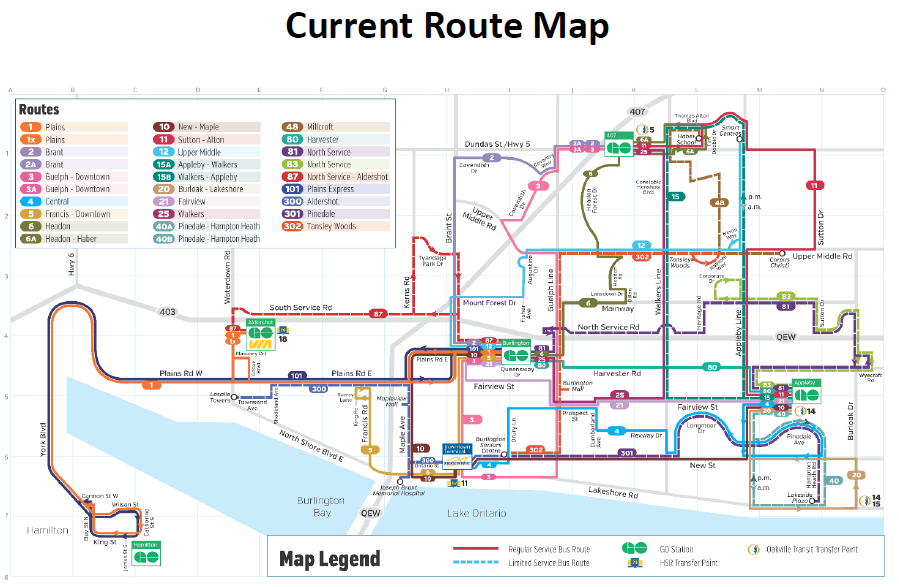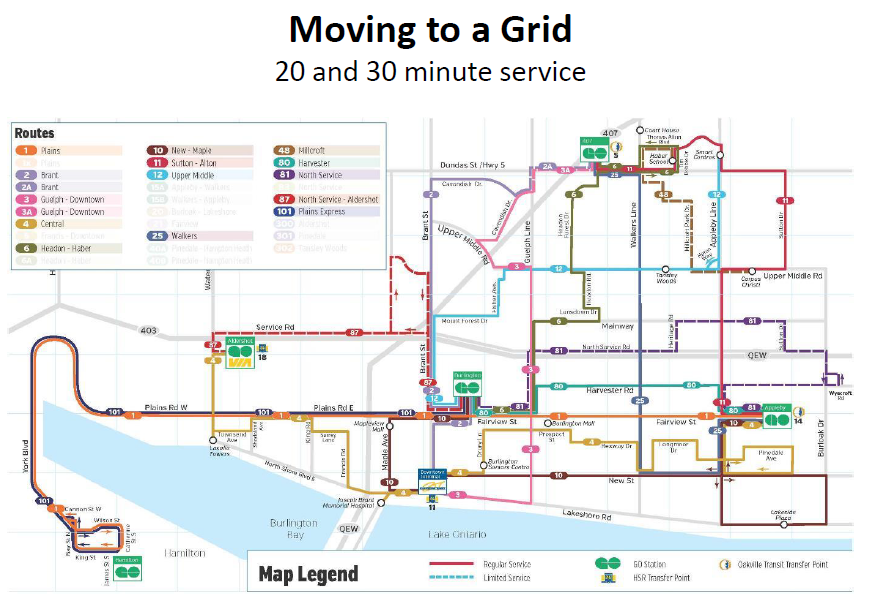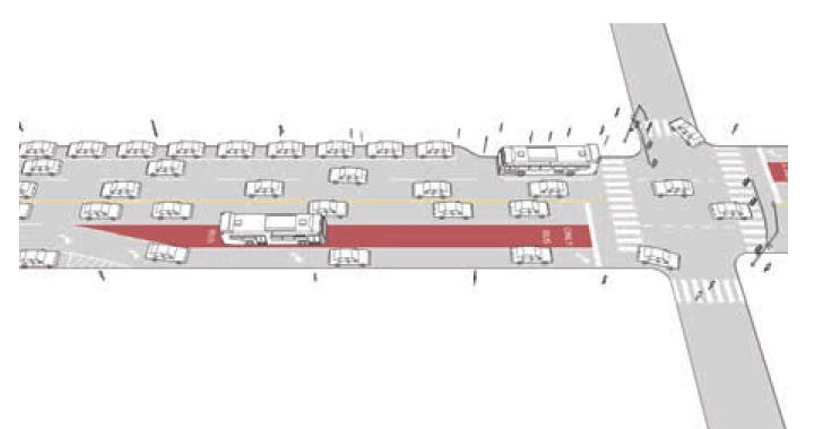 By Pepper Parr
By Pepper Parr
July 25th, 2019
BURLINGTON, ON
This is a seven part series on transit and how Burlington plans to get to the point where the public will take public transit to get to where they want to go in the city because it is cheaper, faster, more convenient and seen as the smart thing to do.
Part 2:
In setting out the plans for creating a more effective transit plan a number of growth strategies were made the focus for staff over the next five years.
These reflect the Burlington Transit the vision, mission and strategic directions noted in the policy framework and will be supported by an updated organizational structure and an implementation and financial plan. These growth strategies are organized into the following themes:
1. Service Structure and Delivery
The Strategies and recommendations to make this happen are set out below.
2. Mobility Management
3. Customer Experience
4. Travel Demand Management
1. Streamline Service Structure and Delivery
The way services are structured and delivered defines the primary customer aspects of any transit system. Where services go, how often vehicles are scheduled, how long the trip takes, how accessible are stops, and how the service is delivered (focus on customer service) are all key factors in residents choosing not only which services to take, but if transit is an option for them at all.
There are a number of strategic directions that will be implemented over the next five years to move towards this ridership growth target. These are described in more detail below:
Strategy 1A: Move to a More Direct Grid-Based System
Burlington Transit has already recognized the benefits that grid-based systems can bring and is making its first steps towards this goal in its September 2019 service change. In order for the grid network to be successful, there must be continued emphasis on:
• Intensification of land use along the arterial roadway network;
• Connectivity to the arterial grid to expand the market within a five-minute walk of the network;
• Improvements to the pedestrian environment at and connected to bus stops; and
• Investments in service levels to limit waiting times for customers that must now transfer between two arterial routes.

The current route system is not working – it was designed for a different time.

A grid route system will mean a significant realignment of vehicles and something people will have to get used to – but it will solve a lot of the current problems.
The Burlington Transit network was developed largely on a grid arterial system, focused on key population and employment areas, with links to the GO Rail network.
Key north-south corridors like Brant and Walkers link the established southern areas to growing northern areas.
Such grid systems allow for more direct routes on arterial roads that are faster, resulting in quicker journeys that attract more riders. While there is a role for local services, the focus of Burlington Transit’s future investment should be on services where they can generate the greatest ridership per invested service hour.
This service realignment works towards Burlington Transit’s Strategic Direction #3 (Be Business-Minded and aligned with municipal directions), particularly Objective 3.1 (Effectiveness), in ensuring that services operated are as effective as possible. Where gaps are left in the network, alternative service delivery options (Strategy 1A) should be explored as a more cost-effective solution to fill them in.
Recommendations:
• Delete circuitous peak-only and after-hours only routes.
• Consider the deletion of circuitous local routes. The removal of these routes should only be considered in concert with the exploration of alternative service delivery options (Strategy 1A).
• Strengthen key arterial corridors and connections to GO Transit stations. Focus on east-west connectivity, with strategic north-south corridors.
Strategy 1B: Increase Service Levels to Support Higher Ridership Growth
Implementing high-frequency service on Burlington’s arterial network may be a challenge given the limited pedestrian connectivity. A number of arterial roads are characterized by rear-lot residential, or long blocks with limited pedestrian connections into interior neighbourhoods.
This makes providing a frequent service on all of the grid-routes a challenge. Since frequency improvements are necessary to facilitate transfers between north-south and east-west routes, Burlington Transit should work with the City’s Planning and Development Department to improve pedestrian connectivity (including road crossings) between arterial transit routes and local neighbourhoods and identify opportunities for mixed-use intensification.
This increase in service levels aligns with Burlington Transit’s Strategic Direction #3 (Be Business-Minded and aligned with municipal directions), particularly Objective 3.1 (Investment), in acknowledging that investment in mobility can improve broader quality of life, achieve economic development and produce environmental benefits.
Recommendations:
• Continue to improve frequencies on Burlington’s arterial grid roads, particularly on the east- west corridors of Plains / Fairview and New, as well as the north-south corridor along Brant.
These corridors are planned to see the most mixed-use, commercial and high density development in Burlington’s Official Plan (2018).
• Work with the City of Burlington Planning and Development Department to increase and enhance pedestrian connectivity between arterial transit routes and local neighbourhoods and identify opportunities for mixed-use intensification along arterial routes.
Strategy 1C: Introduce Transit Priority Features to Improve System Reliability
Transit signal priority works by prioritizing the flow of transit vehicles at controlled intersections. Transponders are fitted to vehicles, which notify traffic light systems of their presence, and request that a green light be extended when transit vehicles are delayed (passive transit signal priority) or that a dedicated signal phase is dedicated to an approaching transit vehicle (active transit signal priority).
Queue jump lanes are transit-only lanes on the approach to, and immediately after, intersections. These lanes allow transit vehicles to ‘jump the queue’ at intersections when they are paired with an active transit signal priority features.

Queue jump lane – it’s a unique idea – and will certainly improve the flow of traffic for buses – drivers in cars will not like it – but we are moving to an occasion when cars ‘share’ the road.
Queue jump lanes and signal priority would be appropriate treatments for important transit arterial routes that see less delays and travel time variability, or operate less frequently. Such corridors include Guelph Line north of the QEW or Appleby Line.
Burlington Transit has already undertaken investigations to pilot transit signal priority on the Plains / Fairview corridor. It is intended that this corridor will act as a pilot for the future implementation of such a system across the broader network. This pilot will be implemented in the first year of the business plan and it is expected that an expansion of transit priority measures will occur within the five year life of the plan.
In addition to potential transit priority measures for Burlington Transit services, Metrolinx’s 2041 Regional Transportation Plan includes transit priority along Dundas Street to central Burlington and Frequent Regional Bus services using HOV lanes on Highway 407.
While these measures are focused on regional trips, the Dundas Street priority will also provide direct benefits to Burlington Transit.
This increase in service levels aligns with Burlington Transit’s Strategic Direction #1 (Be Customer- Focused in every aspect of how service is delivered), particularly Objective 1.1 (Service Excellence) and Objective 1.3 (Travel Time) by exploring transit priority measures to achieve faster and more reliable journeys. It also aligns with Burlington Transit’s Strategic Direction #2 (Be Forward-Thinking about how Services are Planned and Delivered), particularly Objective 2.1. (Technology) by exploring new technology to improve reliability and travel time.
Recommendations:
• Implement currently-planned pilot transit priority project on Plains / Fairview corridor.
• Conduct a study of transit priority needs in both the short and long term in Burlington. The study should include a prioritization of potential projects following the pilot.
• Initiate discussions with Metrolinx and advocate for the implementation of transit priority on Dundas Street and Brant Street as part of the overall Dundas BRT project. Ensure that their plans align with Burlington Transit’s needs and complement other transit priority projects.
Strategy 1D: Improve Connections to the GO Transit Network
Services from these stations connect Burlington to Toronto as often as every 5-10 minutes during peak periods and every 30 minutes during non-peak times. Limited peak service is also provided to Hamilton. Almost all of Burlington Transit’s routes currently connect to at least one GO Station, providing a logical transfer point between Burlington Transit routes and links to destinations outside of Burlington. Between 3 – 12 percent of GO Rail passengers in Burlington use Burlington Transit to connect to GO Rail services at each of its stations. This suggests that there is room to grow this market to reach Burlington Transit’s ridership growth targets.
By 2025, Metrolinx plans to improve all-day frequencies on the Lakeshore West Line between Aldershot GO Station and Union Station to every 15 minutes, as part of the “Regional Express Rail” initiative. This will also see travel times between Burlington GO and Union Station reduced by up to 19 minutes, as well as 2 minute savings between Burlington GO and Appleby GO. Regional Express Rail will increase the attractiveness of the service for trips to Union Station as well as other mid-line stations along the Lakeshore West line.
This partnership works towards Burlington Transit’s Strategic Direction #3 (Be Business-Minded and aligned with municipal directions), particularly Objective 3.2 (Partnerships) as it seeks to achieve better and more cost effective options for passengers by working with other transit providers.
Recommendations:
• Improve frequency of direct connections to GO Rail stations with the introduction of RER.
• Explore on-demand alternative service delivery strategies to connect to all GO Train trips that do not conveniently connect to a fixed-route Burlington Transit bus.
• Explore integration opportunities to better utilize the RER network for local express trips within the City. This should include improvements to trip planning tools, marketing and communications and well as service integration.
• Investigate the implementation of a fully-integrated single fare with GO Transit. This would require local trips to be priced on the basis of distance.
Strategy 1E: Increase Service Integration with Neighbouring Transit Systems
There is also a significant travel demand between Burlington and Hamilton and Burlington and Oakville that should be addressed as a key strategy to grow ridership. This can be done through improved coordination and service integration that will reduce duplication of service and create a more seamless experience for the customer.
Burlington Transit already offers a level of fare integration with its neighbouring systems. Transfers from Hamilton Street Railway and Oakville Transit are accepted on some services, both in paper form or automatically calculated by Presto. As part of increased utilization of and integration with GO Train services, there exists the opportunity to further reduce fare friction in the region, by adopting a single fare system across multiple systems.
There is an opportunity to strengthen and add to these links with Hamilton and Oakville through service integration. Such a shared service model could provide Burlington with cost savings for the provision of services at its borders and improve seamless passenger connections.
This initiative aligns with Burlington Transit’s Strategic Direction #3 (Be Business-Minded and aligned with municipal directions), particularly Objective 3.2 (Partnerships) as it seeks to achieve better and more cost effective options for passengers through working with other transit providers.
Recommendations:
• Meet with HSR and Oakville Transit to identify opportunities to further integrate services through sharing and coordinated timetabling and routing.
• Investigate the implementation of a fully-integrated single fare with neighbouring systems and GO Transit (see Strategy 2D). This would require local trips to be priced on the basis of distance.
There is some very solid thinking set out in this part of the background on the Burlington Transit five year plan.. Burlington has not seen this level of professionalism applied to transit before nor has the phrase “Be Customer- Focused in every aspect” been part of the language used as a guiding principle for transit in Burlington.
That phrase alone justifies the years of advocacy on the part of Bfast for better transit service
Part 1: Transits five year plan has what some might call an over abundance-of wishful thinking

















